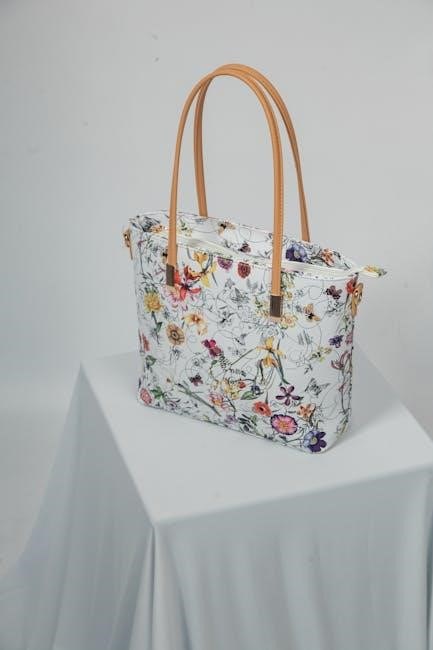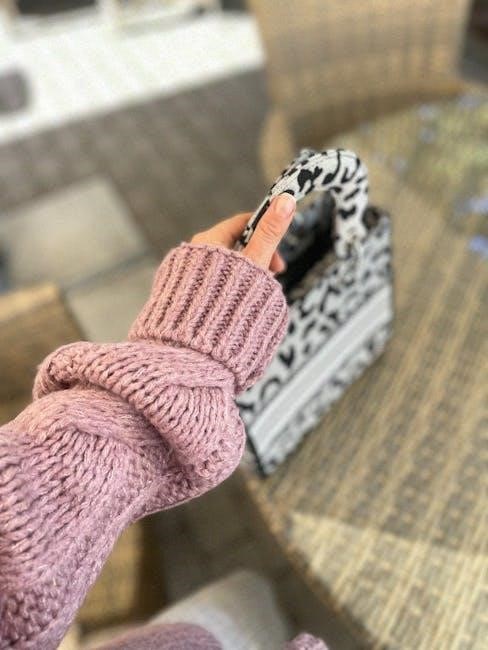Handbag patterns PDF offer a versatile way to create stylish, functional bags. With various designs, from totes to clutches, these patterns inspire creativity for sewists of all levels.
Overview of Handbag Sewing Patterns
Handbag sewing patterns offer a wide variety of designs, from simple totes to elegant clutches. These patterns provide detailed instructions, measurements, and cutting guides, making it easy to create professional-looking bags. Whether you’re a beginner or an experienced sewer, PDF patterns are versatile and customizable. They often include step-by-step tutorials, ensuring a smooth sewing process. Popular styles include crossbody bags, shoulder bags, and messenger bags, catering to different preferences and needs. With downloadable PDFs, you can access patterns instantly, allowing you to start your project right away. Many designs are free, while others offer premium features like advanced techniques or exclusive materials. Handbag patterns are a great way to explore creativity and craft unique accessories for personal use or as gifts.
Why Choose PDF Patterns for Handbags?
PDF patterns for handbags are a convenient and cost-effective option for sewists. They offer instant downloads, eliminating the need for physical shipping; With PDFs, you can print only the pages you need, saving paper and space. These patterns are highly customizable, allowing you to adjust sizes, fabrics, and details to suit your preferences. Many PDF patterns are free or affordable, making them accessible to everyone. They also come with clear instructions and diagrams, making it easier to follow along, even for beginners. Plus, PDFs are environmentally friendly and can be easily stored on digital devices for future use. This makes them a practical choice for crafting unique and personalized handbags.
Types of Handbag Patterns Available
Handbag patterns PDF offer a wide variety of designs, including totes, clutches, crossbody, shoulder, and messenger bags. Each style caters to different needs, ensuring a perfect fit for every occasion and preference.
Tote Bag Patterns
Tote bag patterns are among the most popular and versatile designs available in PDF formats. These patterns are perfect for beginners and experienced sewists alike, offering simplicity and practicality. With a wide range of styles, from classic to modern designs, tote bags can be tailored to suit any occasion. Many free PDF patterns feature easy-to-follow instructions, allowing users to create functional and fashionable bags. Whether you’re making a grocery tote, a beach bag, or a stylish everyday carryall, these patterns provide endless customization options. Fabric choices, pocket placements, and strap designs can be personalized to match your preferences. Tote bag patterns are a great way to start your handbag-making journey, offering quick results and a sense of accomplishment.
Clutch and Crossbody Bag Patterns
Clutch and crossbody bag patterns are ideal for creating elegant, compact accessories. These PDF designs cater to both casual and formal events, offering a chic way to carry essentials. Clutch patterns often feature sleek shapes and decorative elements, while crossbody bags emphasize convenience with adjustable straps. Many free PDF patterns include step-by-step guides, making them accessible to beginners. Whether you opt for fabric, leather, or a combination, these patterns allow for creative expression. Add embellishments like zippers, buckles, or embroidery to give your bag a unique touch. Perfect for parties, outings, or everyday use, clutch and crossbody bag patterns offer versatility and style for any occasion.
Shoulder and Messenger Bag Patterns
Shoulder and messenger bag patterns are perfect for practical yet stylish designs. These PDF templates offer versatility, suitable for everyday use or travel. Shoulder bags feature adjustable straps and roomy interiors, while messenger bags often include flap closures and multiple compartments. Many patterns are designed for durability, incorporating reinforced seams and sturdy materials. Whether you prefer fabric or leather, these patterns cater to various skill levels. Embellishments like rivets or pockets can enhance functionality and aesthetics. Ideal for work, school, or casual outings, shoulder and messenger bags are timeless choices for sewists aiming to create functional, fashionable accessories with ease.

Popular Materials for Handbag Sewing
Popular materials for handbag sewing include durable fabrics like canvas, denim, and leather. These options ensure strength and style, perfect for creating long-lasting, fashionable bags.
Fabric Selection for Handbags
Fabric selection is crucial for handbag sewing, as it determines both durability and style. Popular choices include sturdy cotton, canvas, and denim for casual designs, while leather offers a luxurious touch. Lightweight fabrics like silk or chiffon are ideal for elegant clutch bags, while nylon or polyester are great for practical, water-resistant options. Consider the intended use of the bag when choosing materials, ensuring they align with the desired aesthetic and functionality. Mixing patterns and textures can add visual interest, while solids provide a clean, timeless look. Proper fabric selection ensures your handbag is both functional and visually appealing, making it a standout accessory.
Leather Handbag Patterns
Leather handbag patterns are a popular choice for sewists looking to create durable, stylish accessories. These patterns often feature classic designs, such as totes, crossbody bags, and shoulder bags, tailored for leatherwork. Leather offers a luxurious aesthetic and long-lasting durability, making it ideal for professional-looking handbags. Many PDF patterns include detailed instructions for working with leather, including tips for cutting, stitching, and finishing. Popular patterns like the “Soofi waist bag” and “leather tote bag” are favorites among crafters. Resources like Emmaline Bags and Somstylecraft provide high-quality leather handbag patterns, perfect for both beginners and advanced sewists. Leather handbags are a timeless choice, blending elegance with practicality, and are a great way to showcase your sewing skills.

Free Handbag Patterns for Beginners
Free handbag patterns are perfect for beginners, offering easy-to-follow designs and tutorials. Start with simple projects like totes or crossbody bags to build confidence and skills.
Best Free PDF Patterns for Tote Bags
Discover the best free PDF patterns for tote bags, perfect for beginners and experienced sewists alike. These patterns offer a variety of styles, from classic to modern designs. Whether you’re looking for a simple, everyday tote or a more structured bag with pockets, there’s a pattern to suit your needs. Popular designs include the Amara Tote & Handbag and the Larkspur Tote Bag, both offering versatility and style. Websites like Emmaline Bags and Sew Yours provide high-quality, downloadable patterns. Tote bags are great for using up fabric scraps and can be customized with embroidery or appliqué. They also make thoughtful gifts or personal projects. Start sewing your perfect tote today with these free resources!
Simple Crossbody Bag Patterns for Beginners
Simple crossbody bag patterns are ideal for beginners, offering easy-to-follow instructions and quick results. These patterns typically require minimal fabric and basic sewing skills, making them perfect for those new to bag making. Popular designs include the Acacia Crossbody Bag and the Alina Crossbody Bag, both available as free PDF downloads. These patterns feature clean lines, straightforward construction, and optional pockets for organization. They are great for using scraps of fabric and can be customized with straps, buckles, or embroidery. Resources like Emmaline Bags and Sew Yours offer tutorials and tips to help beginners master these designs. Start your sewing journey with these easy and stylish crossbody bag patterns!

Advanced Handbag Sewing Techniques
Advanced handbag sewing techniques offer professional finishes and structural integrity. Explore expert methods through detailed PDF guides for a polished, customizable look.
Embellishments and Decorative Elements
Embellishments and decorative elements elevate handbags from functional to fashionable. Techniques like adding zippers, buckles, or appliqué can enhance both style and utility. Fabric choices, such as leather or vibrant prints, add uniqueness. Hardware like magnetic snaps or rivets can provide a professional finish. Many PDF patterns include guides for incorporating these details seamlessly. For instance, the Acacia crossbody bag pattern offers step-by-step instructions for installing zippers and straps. Similarly, the Amara Tote & Handbag pattern highlights how to add decorative stitching or pockets. These elements not only personalize the bag but also reflect the maker’s creativity. Resources like Emmaline Bags and Miko Craft’s tutorials on YouTube provide inspiration and practical tips for mastering these techniques.
Reinforcements and Stabilizers for Durability
Reinforcements and stabilizers are essential for creating long-lasting handbags. Interfacing, fusible fleece, and rigid stabilizers like Pellon or Kraft-Tex add structure and prevent sagging. These materials ensure bags maintain their shape, especially for styles like totes or shoulder bags. PDF patterns often include specific recommendations for stabilizers, guiding sewists on where and how to apply them. For example, the Amara Tote & Handbag pattern suggests using heavy-duty interfacing for the bottom panel to enhance durability. Proper use of these elements not only extends the bag’s lifespan but also improves its functionality and professional finish. Many resources, such as tutorials on YouTube and sewing blogs, offer tips for selecting and applying the right stabilizers for various bag types.
Tools and Hardware for Handbag Making
Essential tools include sewing machines, rotary cutters, and rulers. Hardware like zippers, magnetic snaps, and D-rings enhance functionality. Resources like Emmaline Bags and Sew Yours offer premium supplies.
Essential Sewing Tools for Bag Making
For successful handbag sewing, essential tools include a reliable sewing machine, sharp rotary cutters, and sturdy rulers. Heavy-duty scissors, seam rippers, and measuring tapes are also vital. A stable work surface and storage for supplies ensure efficiency. Sewing machines with heavy-duty settings can handle thick fabrics like leather or canvas. Rotary cutters and mats help achieve precise cuts, while rulers guide accurate measurements. Seam rippers correct mistakes without damaging fabric. Investing in high-quality tools ensures professional results and streamlines the bag-making process. These tools are fundamental for bringing handbag patterns to life, whether working with fabrics, leather, or mixed materials.
Hardware and Accessories for Professional Finishes
Professional hardware and accessories elevate handbags, ensuring durability and aesthetics. Items like magnetic snaps, zippers, and metal rings add functionality. Swivel hooks and adjustable straps offer versatility. High-quality buckles and rivets enhance the design, while reinforced handles provide strength. D-rings and sliders allow for customizable bag configurations. Interfacing and stabilizers are also crucial for structure. These elements ensure a polished look and longevity, making bags more appealing and user-friendly. Incorporating such details transforms a simple project into a professional-grade accessory, satisfying both practical and style needs.

Tutorials and Guides for Handbag Sewing
Discover step-by-step tutorials and guides for sewing handbags. From beginner-friendly instructions to advanced techniques, these resources help craft beautiful bags with confidence and precision.

Step-by-Step Sewing Tutorials for PDF Patterns
Step-by-step sewing tutorials for PDF patterns provide clear guidance for crafting handbags. These detailed instructions, often paired with visuals, help sewists of all skill levels follow along effortlessly. Many tutorials include tips for selecting fabrics, cutting accurately, and assembling components. Platforms like Emmaline Bags and Miko Craft on YouTube offer excellent resources, including free PDF patterns and video demonstrations. These guides cater to both beginners and experienced sewists, ensuring a smooth sewing process. Whether you’re making a tote, clutch, or crossbody bag, these tutorials offer expert advice to achieve professional results. They also cover finishing techniques, hardware installation, and troubleshooting common mistakes. With these resources, you can confidently bring your handbag designs to life.
Video Resources for Learning Handbag Sewing
Video resources for handbag sewing are invaluable for visual learners. Platforms like YouTube and crafting websites offer step-by-step tutorials that guide you through each stage of bag making. Channels such as Miko Craft and Emmaline Bags provide detailed videos for various handbag styles, from totes to crossbody bags. These videos often complement free PDF patterns, demonstrating how to cut fabric, assemble components, and add hardware. Many tutorials also cover advanced techniques, such as adding linings, zippers, and decorative elements. Additionally, video guides address common mistakes and offer troubleshooting tips, ensuring a polished finish. Whether you’re a beginner or an experienced sewist, these video resources enhance your skills and confidence in creating professional-looking handbags.


Customization and Personalization Ideas
Customize your handbags with unique details like embroidery, appliques, or contrasting stitching. Personalize further by upcycling materials or adding functional elements to make each bag truly special.

Adding Unique Details to Your Handbags
Adding unique details to your handbags can elevate them from ordinary to extraordinary. Consider incorporating embroidery, appliques, or contrasting stitching to create a personalized touch. Upcycling materials like vintage fabrics or repurposed leather can add an eco-friendly and exclusive flair. Functional elements such as decorative zippers, magnetic snaps, or adjustable straps can enhance both style and usability. For a modern twist, experiment with hardware like rivets or buckle details. These customizations not only reflect your personal style but also make each handbag a one-of-a-kind creation. With endless possibilities, you can tailor every bag to suit your taste and needs perfectly.
Upcycling and Repurposing Materials
Upcycling and repurposing materials breathe new life into old items, creating unique handbags with a sustainable twist. Transform vintage fabrics, denim, or leather jackets into one-of-a-kind bags. Old scarves, belts, or even plastic bags can be repurposed for accents or embellishments. This eco-friendly approach not only reduces waste but also adds character to your designs. For example, use leftover fabric scraps to create patchwork details or turn plastic bottles into sturdy bag bases. Mixing materials like canvas and leather can yield striking textures. Upcycling allows you to experiment creatively while giving discarded items a fresh purpose. It’s a budget-friendly way to craft handbags that tell a story and reflect your commitment to sustainability.

Troubleshooting Common Sewing Issues
Addressing sewing challenges like uneven seams, misaligned fabric, or hardware installation issues ensures professional results. Adjust patterns, check measurements, and use stabilizers to resolve common handbag sewing problems effectively.
Fixing Common Mistakes in Bag Sewing
Common mistakes in bag sewing, such as uneven seams or misaligned hardware, can be easily corrected with attention to detail. Ensure accurate pattern alignment and proper seam allowances. For puckered fabric, check thread tension or fabric grain alignment. Incorrect interfacing can cause stiffness; choose the right weight for your material. If straps are misaligned, reposition them before sewing. Use a walking foot for thick fabrics and reinforce stress points with stabilizers. Refer to tutorials for visual guidance. Regularly backstitch at seams for durability. Fixing errors early prevents larger issues, ensuring a polished finish. Practice makes perfect, so don’t hesitate to start over if needed for professional results.
Tips for Achieving Professional Results
Achieving professional results in handbag sewing involves careful planning and execution. Start by selecting high-quality materials, ensuring fabric and hardware align with your design. Use precise measurements and cut accurately, as small errors can affect the final look. Interface or stabilize fabrics where needed to maintain structure. Topstitching adds a polished finish, so choose complementary thread colors. For a clean interior, opt for coordinating linings. Reinforce seams with stay tape or stabilizers to enhance durability. Follow pattern instructions closely and watch video tutorials for complex steps. Pressing seams as you go ensures a crisp, professional appearance. Pay attention to hardware placement for functionality and aesthetics. With patience and attention to detail, your handmade bags will look store-bought and stand the test of time.
Resources for Handbag Patterns and Supplies
Discover top websites offering free and paid PDF patterns for handbags. Explore high-quality materials and hardware suppliers to bring your designs to life with professional finishes.
Top Websites for Free and Paid PDF Patterns
Explore a variety of websites offering both free and paid PDF handbag patterns. Popular platforms like Emmaline Bags and Sew Yours provide high-quality, downloadable designs. For free options, Pinterest and crafting blogs often feature curated lists of PDF patterns for totes, clutches, and more. Paid sites like Craftsy and Etsy offer exclusive designs with detailed instructions. Additionally, YouTube channels such as Miko Craft share trendy PDF patterns for DIY enthusiasts. These resources cater to all skill levels, ensuring you can find the perfect pattern to match your sewing goals. Whether you’re a beginner or an advanced sewist, these websites offer endless inspiration and practical tools for creating stunning handbags.
Where to Buy High-Quality Materials and Hardware
For crafting stunning handbags, sourcing high-quality materials and hardware is essential. Websites like Sew Yours and Emmaline Bags specialize in premium fabrics, exclusive hardware, and tools tailored for bag making. Platforms like Craftsy and Etsy also offer a wide range of materials, from durable leathers to stylish zippers and buckles. For leather enthusiasts, sites like patterns.somstylecraft.ru provide excellent resources. Additionally, local craft stores and online marketplaces like Amazon often carry a variety of supplies. When selecting materials, consider durability, aesthetics, and compatibility with your pattern. Investing in quality hardware ensures a professional finish, while the right fabric choice enhances both functionality and style. Always opt for tools designed specifically for bag sewing to achieve polished results.
